
In geology and mineralogy, a mineral or mineral species is, broadly speaking, a solid substance with a fairly well-defined chemical composition and a specific crystal structure that occurs naturally in pure form.

Hornblende is a complex inosilicate series of minerals. It is not a recognized mineral in its own right, but the name is used as a general or field term, to refer to a dark amphibole. Hornblende minerals are common in igneous and metamorphic rocks.

Amphibole is a group of inosilicate minerals, forming prism or needlelike crystals, composed of double chain SiO
4 tetrahedra, linked at the vertices and generally containing ions of iron and/or magnesium in their structures. Its IMA symbol is Amp. Amphiboles can be green, black, colorless, white, yellow, blue, or brown. The International Mineralogical Association currently classifies amphiboles as a mineral supergroup, within which are two groups and several subgroups.

The pyroxenes are a group of important rock-forming inosilicate minerals found in many igneous and metamorphic rocks. Pyroxenes have the general formula XY(Si,Al)2O6, where X represents calcium (Ca), sodium (Na), iron or magnesium (Mg) and more rarely zinc, manganese or lithium, and Y represents ions of smaller size, such as chromium (Cr), aluminium (Al), magnesium (Mg), cobalt (Co), manganese (Mn), scandium (Sc), titanium (Ti), vanadium (V) or even iron. Although aluminium substitutes extensively for silicon in silicates such as feldspars and amphiboles, the substitution occurs only to a limited extent in most pyroxenes. They share a common structure consisting of single chains of silica tetrahedra. Pyroxenes that crystallize in the monoclinic system are known as clinopyroxenes and those that crystallize in the orthorhombic system are known as orthopyroxenes.

Actinolite is an amphibole silicate mineral with the chemical formula Ca2(Mg4.5–2.5Fe2+0.5–2.5)Si8O22(OH)2.
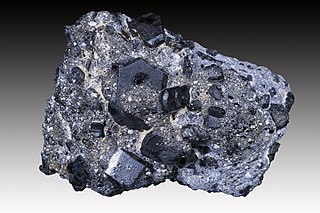
Augite, also known as Augurite, is a common rock-forming pyroxene mineral with formula (Ca,Na)(Mg,Fe,Al,Ti)(Si,Al)2O6. The crystals are monoclinic and prismatic. Augite has two prominent cleavages, meeting at angles near 90 degrees.
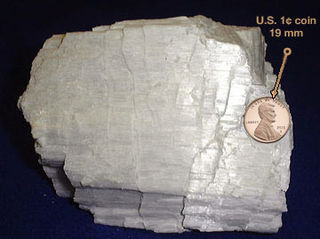
Wollastonite is a calcium inosilicate mineral (CaSiO3) that may contain small amounts of iron, magnesium, and manganese substituting for calcium. It is usually white. It forms when impure limestone or dolomite is subjected to high temperature and pressure, which sometimes occurs in the presence of silica-bearing fluids as in skarns or in contact with metamorphic rocks. Associated minerals include garnets, vesuvianite, diopside, tremolite, epidote, plagioclase feldspar, pyroxene and calcite. It is named after the English chemist and mineralogist William Hyde Wollaston (1766–1828).
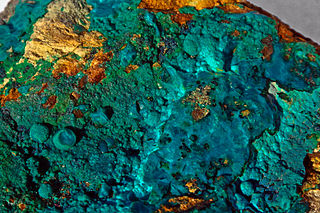
Silicate minerals are rock-forming minerals made up of silicate groups. They are the largest and most important class of minerals and make up approximately 90 percent of Earth's crust.
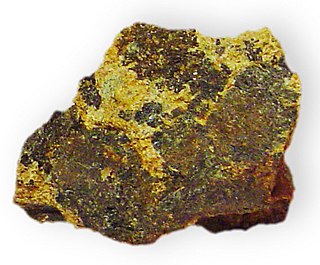
Cummingtonite is a metamorphic amphibole with the chemical composition (Mg,Fe2+
)
2(Mg,Fe2+
)
5Si
8O
22(OH)
2, magnesium iron silicate hydroxide.

Frank Christopher Hawthorne is a Canadian mineralogist, crystallographer and spectroscopist. He works at the University of Manitoba, Winnipeg, Manitoba, Canada, and is currently Distinguished Professor Emeritus. By combining Graph Theory, Bond-Valence Theory and the moments approach to the electronic energy density of solids he has developed Bond Topology as a rigorous approach to understanding the atomic arrangements, chemical compositions and paragenesis of complex oxide and oxysalt minerals.
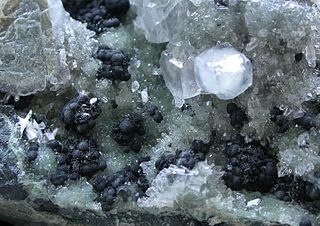
Julgoldite is a member of the pumpellyite mineral series, a series of minerals characterized by the chemical bonding of silica tetrahedra with alkali and transition metal cations. Julgoldites, along with more common minerals like epidote and vesuvianite, belong to the subclass of sorosilicates, the rock-forming minerals that contain SiO4 tetrahedra that share a common oxygen to form Si2O7 ions with a charge of 6− (Deer et al., 1996). Julgoldite has been recognized for its importance in low grade metamorphism, forming under shear stress accompanied by relatively low temperatures (Coombs, 1953). Julgoldite was named in honor of Professor Julian Royce Goldsmith (1918–1999) of the University of Chicago.

The endmember hornblende tschermakite (☐Ca2(Mg3Al2)(Si6Al2)O22(OH)2) is a calcium rich monoclinic amphibole mineral. It is frequently synthesized along with its ternary solid solution series members tremolite and cummingtonite so that the thermodynamic properties of its assemblage can be applied to solving other solid solution series from a variety of amphibole minerals.
Akimotoite is a rare silicate mineral in the ilmenite group of minerals, with the chemical formula (Mg,Fe)SiO3. It is polymorphous with pyroxene and with bridgmanite, a natural silicate perovskite that is the most abundant mineral in Earth's silicate mantle. Akimotoite has a vitreous luster, is colorless, and has a white or colorless streak. It crystallizes in the trigonal crystal system in space group R3. It is the silicon analogue of geikielite (MgTiO3).

Edenite is a double chain silicate mineral of the amphibole group with the general chemical composition NaCa2Mg5(Si7Al)O22(OH)2. Edenite is named for the locality of Edenville, Orange County, New York, where it was first described.

Chesterite is a rare silicate mineral that can be compared to amphiboles, micas, and jimthompsonite. Its chemical formula is (Mg,Fe)
17Si
20O
54(OH)
6. Chesterite is named after Chester, Vermont, where it was first described in 1977. The specific geologic setting within its origin is the Carleton talc quarry in Chester, Vermont.

Vlasovite is a rare inosilicate (chain silicate) mineral with sodium and zirconium, with the chemical formula Na2ZrSi4O11. It was discovered in 1961 at Vavnbed Mountain in the Lovozero Massif, in the Northern Region of Russia. The researchers who first identified it, R P Tikhonenkova and M E Kazakova, named it for Kuzma Aleksevich Vlasov (1905–1964), a Russian mineralogist and geochemist who studied the Lovozero massif, and who was the founder of the Institute of Mineralogy, Geochemistry, and Crystal Chemistry of Rare Elements, Moscow, Russia.

Tuperssuatsiaite is a rare clay mineral found in Greenland, Namibia and Brazil. It is a hydrated phyllosilicate of sodium and iron.

Magnesiohastingsite is a calcium-containing amphibole and a member of the hornblende group. It is an inosilicate (chain silicate) with the formula NaCa2(Mg4Fe3+)(Si6Al2)O22(OH)2 and molar mass 864.69 g. In synthetic magnesiohastingsite it appears that iron occurs both as ferrous iron Fe2+ and as ferric iron Fe3+, but the ideal formula features only ferric iron. It was named in 1928 by Marland P. Billings. The name is for its relationship to hastingsite and its magnesium content. Hastingsite was named for the locality in Dungannon Township, Hastings County, Ontario, Canada.

Ferrogedrite is an amphibole mineral with the complex chemical formula of ☐Fe2+2(Fe2+3Al2)(Si6Al2)O22(OH)2. It is sodium and calcium poor, making it part of the magnesium-iron-manganese-lithium amphibole subgroup. Defined as less than 1.00 apfu (atoms per formula unit) of Na + Ca and consisting of greater than 1.00 apfu of (Mg, Fe2+, Mn2+, Li) separating it from the calcic-sodic amphiboles. It is related to anthophyllite amphibole and gedrite through coupled substitution of (Al, Fe3+) for (Mg, Fe2+, Mn) and Al for Si. and determined by the content of silicon in the standard cell.

Lizardite is a mineral from the serpentine subgroup with formula Mg3(Si2O5)(OH)4, and the most common type of mineral in the subgroup. It is also a member of the kaolinite-serpentine group.



















